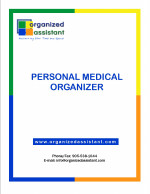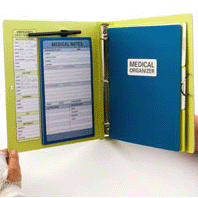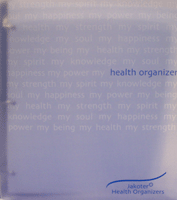Vital Signs: Maintaining Your Family’s Medical Records–Part 1 (Paper)
Quick! Do you know when you received your last tetanus booster shot? What’s the address and contact number of your health insurance company? Has your blood pressure (or cholesterol or other test results) changed much over the past few years?
Some time ago, we discussed the importance of maintaining a medical records section of your Family Files. In that post, we discussed why it was important to maintain your own medical records (rather than depending on the doctor to safeguard them), as well as what kind of medical contacts and documents needed to be saved.
Most of us live in hope that we’ll never need to review our old medical information. For many, just popping a copy of our medical, dental and vision records in a folder acts as karmic insurance against needing to procure or review that information. However, sometimes life does not go according to plan.
As we’ve been discussing over the last few weeks (here and here), it’s not only beneficial but sometimes essential to gather information before and during a medical emergency to help you receive the best medical treatment possible. Later, when the crisis has passed, and you have to start making the rounds of new doctors (often specialists in ailments you previously might have thought were the names of not-yet-developed nations), you’ll need to have a variety of information at your fingertips in order to fill out forms (even the same forms, over and over, at the same doctor’s office you visited just the week before), to apply for disability or Worker’s Compensation, to answer your doctors’ inquiries, to catch any inconsistencies or better understand explanations.
The question is, how much do you need to know in advance and how should you gather this data?
Low-Tech, No Cost
If you’re the type who loves to follow my advice for free or almost-free options for filing recipes or documents, you might like creating your own database of information, either handwritten on notebook paper or printed from the computer, using Microsoft Excel or Word (or the free Google versions of each) for easy maintenance and revision. Contain all of the following in a plain three-ring binder for ease of access and portability.
To get started, capture the information you should know by heart, but which you might forget in an emergency, or even if you’ve had a particularly stressful day, as well as the information you would otherwise have to keep looking up. This can include:
Basic information (about you, or about the individual to whom the notebook refers):
- Name, full address, phone numbers (home, work, cell)
- Age and birthdate (yes, it does seem redundant, but medical forms almost always ask for both. In a frazzled moment, it’s easy to forget your age (especially if you’re forever 29), and if one of your children were ill, it’s understandable that you’d become so nervous that you might mix up their birthdays)
- Emergency medical contact‘s name, full address, phone numbers (This is especially important if your emergency medical contact is a sibling or friend who changes phone numbers often. If you rely on speed-dial, it will be hard to recollect the number when you urgently need it.)
- Employer’s contact information, including your supervisor’s name and contact information, if applicable for Worker’s Compensation or other labor-related documentation
- School contact information, especially if your physician will have to write a letter documenting your (or your child’s condition) to allow for either a return to classes/activities or permission to abstain from them.
- Primary insurance information, including your group number, your personal identification number, the insurance company’s member service phone number and the provider service phone number. (This should be on your insurance card; for convenience, you could photocopy the front and back of your card rather than writing down all of the information.)
- Secondary insurance information, the same as described above. (Not sure what secondary insurance is? Think of that Aflac-quacking duck. Sometimes, primary insurance will cover 80% of your bills after you’ve hit your deductible, up to the total of your out-of-pocket medical costs. Secondary insurance may reimburse up to 80% of the remaining out-of-pocket costs–that is, what’s not covered by your primary insurance.)
- Primary care physician’s and applicable specialists contact information and list of hospitals where they have admitting privileges.
Medical History/Information:
- Allergies (to medicines, foods, etc.)
- Blood type (No medical establishment is likely to take your word for this; they’ll have to draw blood anyway. However, knowing your blood type and Rh factor can help in other circumstances, such as when particular blood donor types are needed.
- Immunization records (including those received for military service or travel abroad)
- Medications (including dosages, instructions regarding frequency and time of day, the prescribing doctor’s contact information, and the name, phone number and location of your regular pharmacy)
- Medical diagnoses and treatments for chronic and acute medical conditions (including treating physicians and their contact information)
- Surgical and hospitalization history (dates, hospitals, physicians and their contact information)
- Family medical history, including your parents’ names, and their pertinent medical histories (diseases/diagnoses/treatments); depending on your conditions, you may need to maintain medical history for your siblings and other close relatives.
Legal Documentation:
- Photocopy of your Living Will/Advanced Care Directive
- Photocopy of your Durable Power of Attorney for Healthcare
- Proof of citizenship or identity
An Inexpensive Calendar
Physicians and forms often ask for dates: when was the date of your last “whatever”? When did each particular symptom start? How long have you had that cough? Tuck a 12-page calendar (the kind local merchants or insurance agencies give you for free) into the front pocket of your three-ring binder to help you visualize and track your symptoms and recall important dates.
Wow. Sounds like a lot, eh? So what if you’re afraid you’ll forget to include something, or you prefer to have a little more guidance. As always, myriad pre-printed options are available to those of you who aren’t do-it-yourselfers in the record-keeping realm:
Low-Tech, Moderate Cost 
Personal Medical Organizer was developed by my blogging colleague, Janet Barclay. She reports that the sections in her binder include spaces for documenting contacts, a medical history and symptom diary, medications, copies of medical reports and correspondence, and even a place to safely locate receipts from doctors’ visits. Although this organizer is produced in Canada, it is designed to be suitable for patients throughout North America and elsewhere.

Medical Organizer Kit sold at OnlineOrganizing.com includes a three-ring binder with nine tabbed sections, storage pockets for sorting and storing important documents, and medical tracking charts. The kit allows you to track your appointment times, treatment instructions, medical histories, contacts, prescriptions, dental care and more.
Low Tech, Higher Cost

Jakoter Health Organizer provides a higher-end approach to tracking your medical information. In addition to thirteen pre-labeled 8.5″W x 11″H pocket folders to maintain medical paperwork (including test results, correspondence with physicians, hospital and medical bills and receipts), this organizer includes forms for prompting you to remember the questions to ask your doctor, a chart to list major health “events” including visits to the ER, hospitalizations and surgeries, information for keeping track of appointments, and more. (For those who feel the need for something fancier than typical three-ring binder, this organizer offers a choice of a vinyl or faux leather cover.)
High Tech, Moderate Cost–To Be Continued
More and more often, we’re hearing about how computerizing medical records is central to healthcare reform. It’s a distinct advantage for our physicians when they can log into a hospital database and pull up our medical records electronically, without delay for delivery or deciphering handwriting. We can anticipate that along with questions about privacy concerns, there will continue to be a push for electronic record maintenance.
That’s great for the doctors, but what about you, as the patient? How can you use technology for maintaining your medical records? From flash drives with pre-loaded data programs to online medical vaults to Google Health, we’re faced with all sorts of alternatives for organizing medical records digitally.
Next week, we’ll be exploring various digital medical recordkeeping options to help you limit the paper clutter, avoid confusion due to creative handwriting or lost paperwork, and increase the ease of portability of your records. Until then, Paper Doll has some homework for you–consider it a prescription for healthy medical recordkeeping. Read what the Privacy Rights Clearinghouse has to say about maintaining your medical records and the drawbacks of doing so online.
Until next week, stay healthy and safe. (And really, do find out when you last had a tetanus booster shot.)




Follow Me